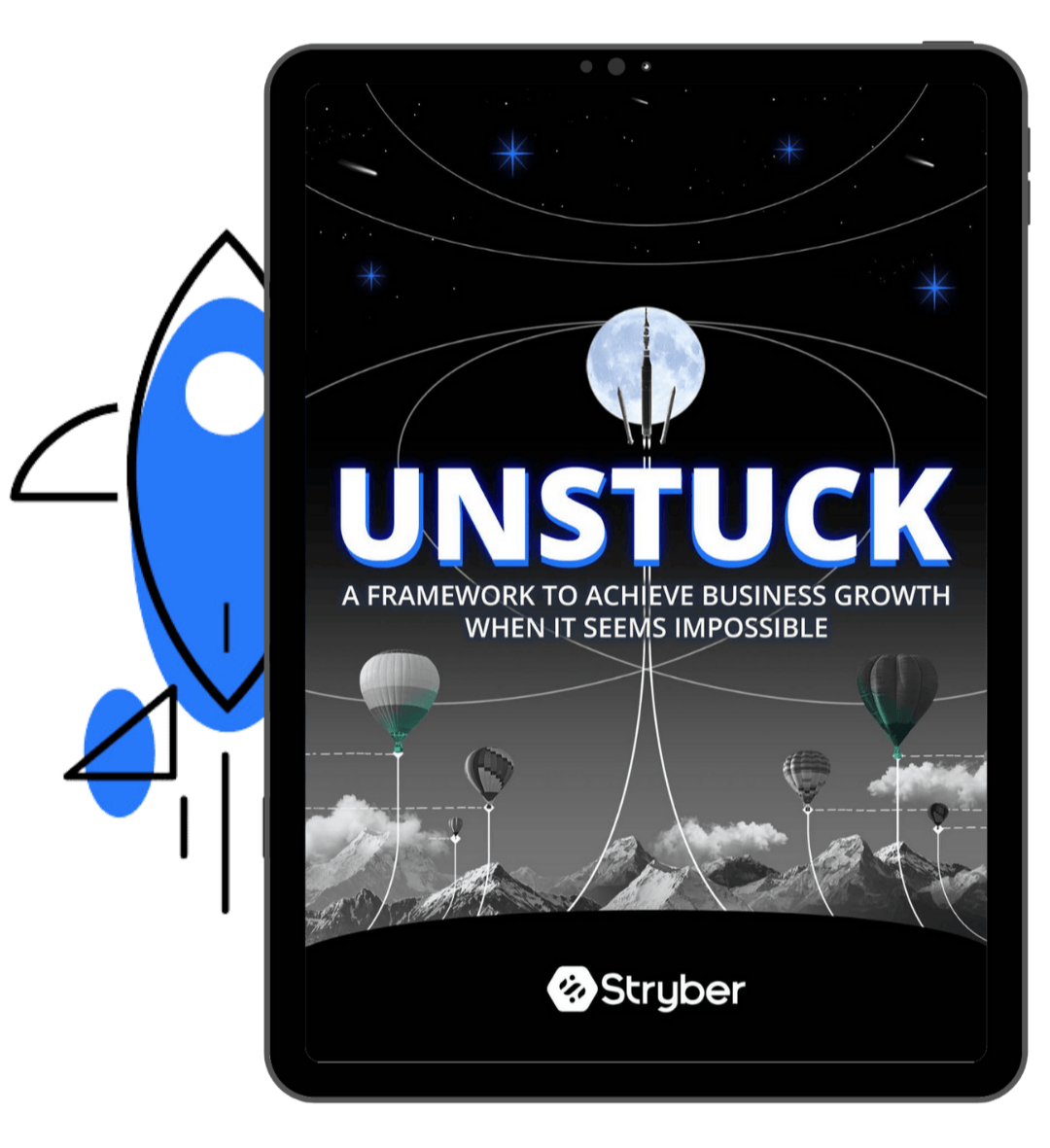The 8 great myths of corporate innovation
Innovation is a challenge in any established business. So why make it more difficult than it needs to be? In this article, we dive into the 8 myths of corporate innovation that are (probably) holding you back.
Innovation is a top-three priority for nearly 4 in 5 companies worldwide. And around two-thirds plan to increase spending (some by a lot). Yet just 6% of CEOs are satisfied with their innovation performance.
Table of Contents
- Myth #1: There's no rush
- Myth #2: We don't need to be first movers
- Myth #3: We can do it ourselves
- Myth #4: We own the customer relationship
- Myth #5: We're the best because we think we are
- Myth #6: We only do things with 9-digit revenue potential
- Myth #7: We can start something with no extra budget
- Myth #8: We must focus on one lighthouse project
- Time to get Unstuck
Of course corporate innovation is hard
Failures far outweigh successes. For all the systems and processes touted across a multitude of business books, the reality is that few large businesses create new breakthrough business models.
So far, so business as usual.
Partly, this is a function of operating in a mature market. Products become increasingly similar. Improvements are often relatively minor and iterative. Customers know what they want (they just want it faster and cheaper).
However, in our conversations with leaders in large, established companies, we tend to hear the same arguments over and over.
This would be fine if they were accurate. But all too often they’re not. They’re myths. And they’re holding these companies back.
Let’s take a look at the eight we encounter most often…
Myth #1: There’s no rush, we’ll wait for a startup to gain traction and then acquire it
Back in the day, many companies would simply buy innovation by acquiring promising upstarts. Why risk your own money when you can test innovations with someone else’s?
But that was then. Today, a five-year-old startup can easily have a higher valuation than your corporate’s enterprise value.
This will often be less a case of snapping up a bargain and more a merger of equals.
What makes it worse is that too many incumbents wait too long to make a decisive deal. Or even if they intend to move early, they’re not ready to pay the strategic premium required.
And that’s before we even get to the relative scarcity of good-fit acquisition targets.

Myth #2: We don’t need to be first movers, we can be followers—and because we’re big, we’ll still make it
So this can work. If a corporate finds a way to use a beneficial parenting advantage or sheer market dominance, it can gain a decisive presence.
Consider how Microsoft Teams has overtaken Slack in user numbers by bundling it into Office 365 and exploiting the risk-aversion of its enormous customer base.
The difference is massive.
As of 2023, Teams reached 320 million monthly active users.
Slack? It’s estimated there were 54.1 million monthly users in 2023.
Is Teams better? No.
Does it matter? Probably not.
But this is an outlier. Most corporates lack the necessary boldness in execution to make it actually happen, especially when it threatens their core business.
Just imagine a bank rolling out an AI-based ETF robo advisor when it already has actively managed funds in its product portfolio.
We all know this is not going to happen until it’s probably too late.
Myth #3: We can do it ourselves if an innovation is interesting enough
Yes, in theory. In the real world? Not so much.
When it comes to trade-off decisions around resources, budget, and attention, innovation will always be at a disadvantage. Corporates can generally manage incremental innovation—improving their customer service app, adding another product to an existing portfolio etc.
What they can’t do is create new business models.
Real innovations (let’s call them “ventures”) take a lot of effort to get them off the ground.
Typically, you won’t have the right team in place. You’ll lack a clear product vision. There won’t be any paying customers yet.
And you’re likely to get caught up in the internal politics and rigid governance that have undermined progress in so many established businesses (check out a case in point here).
As such, it becomes nearly impossible to get the necessary resources.
And that’s before the uncomfortable fact that real innovations are often disruptive to existing product lines. Organizations geared towards minimizing risks, where power is distributed by revenue share, are a pretty hostile environment for fragile innovations.
It's time to get Unstuck
If you're leading an established business with persistent growth challenges, we've published a new in-depth framework which includes a detailed look at our Growth Sphere Model.
In the framework, we explore why so many large organizations struggle with growth. Finally, we unpack the most-used strategies deployed by businesses today. We analyze their pros and cons and highlight why you may or may not want to explore them for your business.
Myth #4: We own the customer relationship—startups don’t
While incumbents own “legacy” customer relationships with some lock-in, smart startups typically focus on a specific line of attack.
This could be a use case that’s important to target customers but which isn’t in the focus of the incumbent. An Achilles’ heel.
Let’s take an example: if you look at the App Store ratings of incumbent banking apps, you will typically find 1–3 star ratings. Challenger banks, however, are typically in the 5 stars.
If the targeted use case (e.g. sharing money, best FX capabilities, etc.) attracts the banks’ best customers, it will soon be a notable threat.
Sure, they’ll still have more customers in absolute numbers but the rot will have started.
(BTW: don’t fool yourself that you “own” your customer relationships. You don’t.)
Myth #5: We’re the best because we think we’re the best
Oh really?
So many corporates often misunderstand their real value proposition. This leads to statements like:
“We are good in XYZ. It’s in our DNA. That’s why we can move into the market late with an also-ran product and win against a unicorn startup.”
A classic example is Deutsche Telekom’s Immmr going against WhatsApp. Deutsche Telekom justified Immmr’s existence by highlighting the EUR 40bn lost in annual SMS revenues worldwide to Whatsapp. Well, that’s problem-focused but definitely not user-centric.
Today, Immmr is a footnote in history and WhatsApp is one of the jewels in Meta’s crown.
No business is entitled to future success, no matter how big and successful they’ve been in the past.
Before Google there was Alta Vista, Ask Jeeves, Lycos and a bunch of others.
And now, even Google faces potentially existential threats from the latest AI innovators.

Myth #6: We only do things that have 9-digit revenue potential within 5 years or are profitable within 2 years
Big businesses are used to focusing their attention on big business opportunities. Everything else is garnish.
Reality is: innovation takes time.
Our research suggests that startups need 3.5 years to become profitable and 6.4 years to mature from seed financing to exit (both median). In contrast, venture capital funds are typically set up for 10–15 years in order to yield a return.
New businesses also need the right degree of separation from the main organization. Close enough to get some parenting advantage, distanced enough to avoid being crushed by the gravity of the core business (more on this in the video below).
What makes corporates think that they can do this any faster?
Most corporates have no experience in launching startups. They may know how to launch new products or rearrange existing ones in order to create new business units. But if you apply similar expectations to a startup, you should be prepared for a world of disappointment.
Myth #7: We can start something with no extra budget and take it from there
Let those crazy sneaker guys in our innovation team set up in a Berlin co-working space and see what happens.
Nothing. Nothing is what happens.
There is no free lunch, especially when it comes to innovation. Launching a website is like opening a supermarket in the middle of the desert.
If no one knows about it, no one will buy (no matter how cheap your free-range organic avocados).
In the real world, you’ll need some budget to prove it might work. Then you’ll need even more budget to make it work in reality.
To put this into context, Crunchbase found that the average successful startup raises USD 41m in venture capital until exit (trade sale or IPO).
Again, why should success come to corporates any cheaper?
Certainly, corporates can use existing assets such as distribution channels, supply chains, etc. However, these come at an opportunity cost.
The good news is that these startups exited for USD 243m on average. So there is some decent value to be created for the corporates’ shareholders.
But, of course, not every startup (corporate or not) will be successful.
If you take onboard the existing data, a corporate will have to ensure the default rate is lower than 83%, which brings us to the next—and by far the most important—myth.
Myth #8: We need to focus on one lighthouse project which must not fail
Corporate executives tend to focus on a very few, very important corporate initiatives. Initiatives that, as a result, are seen as too important to fail.
In a corporate’s daily business, this makes absolute sense. The core business will continue to run regardless.
However, in innovation this is completely wrong.
Have you seen a single venture capital fund that puts all its money into one asset? Probably not.
And there’s a good reason: you have to spread the risk in your portfolio. Many startups fail, that’s just the ugly truth.
If corporates want to achieve a reasonable return, they will have to build a) a pipeline and b) a portfolio of ventures. The basic rule of never having all your eggs in one basket applies.
All too often, myths are the lies we tell ourselves to avoid facing the reality of the world around us.
In most, there is a kernel of truth (just enough to maintain the pretense). However, myths such as the eight listed above are likely to contribute to why large, established businesses get stuck in their quest for growth.
The sooner you put these to bed, the sooner you’ll get unstuck.
It’s time to get Unstuck
If you’re leading an established business with significant growth challenges, we’ve published a new in-depth analysis you should check out:
Unstuck: How to achieve business growth when it seems impossible.
In the guide, we explore why so many large organizations struggle with growth.
Finally, we unpack the seven most-used strategies used by businesses like yours today. We analyze their pros and cons. And we highlight why you may or may not want to explore them for your own business. If you liked this article, you’ll love it.
Want to discuss how Stryber can help?

You may also like
These related articles

Sustained business growth: why it's so hard and why gravity matters

Why innovation programmes fail (and what to do instead)

